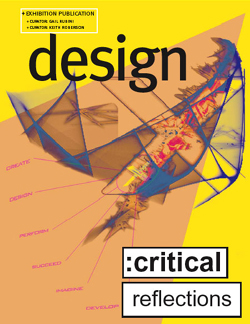The Law of Diminishing Astonishment*
Conrad Gleber
October 2002
What are the essential qualities of design that should be
taught?
Design reifies acts of meaning into structures that fulfill a purpose. The purpose of any design is fueled by desire, identified and distilled from a shared common understanding, intersubjectivity. The development of design proceeds as an interaction between agency and purpose, how and why, technology and intent. As students develop a design practice for themselves they need to recognize the role each contributes to the process of design.
The purpose, the why or the intent of design is informed by intersubjectivity. It is socially mediated action that results in meaningful design. It relies on an intuitive sense of knowing the mind of others. It places the context of design into social interaction.
Just as important, is to recognize that how to design cannot reach an ideal endpoint. Technology solves problems. It is full of irony. At first, the ability to structure meaning in a new way is seductive and novel. Widespread use creates familiarity and eventually the techniques, born out of use, fail to satisfy the enthusiasm for the practice—it’s the Law of Diminishing Astonishment.
Design may be born of desire but it begs the designer to wonder what kind of world is desired. On what ideals does desire rest to push design? The focus of this writing is the education of designers. In particular the changing scope of what students of design must learn. Most design education is training and follows an apprenticeship or situated problem-solving program. If design includes society’s needs and concerns as an ideal end point to development then how something is done is only part of what a student must mediate to practice design. Society, placed in the role of client, enables design to measure the degree of alignment that values and practices have with the environment. It enables the critical evaluation, reflection and display of how well culture is in-sync and balanced with nature.
What are the essential means of design today?
Designing today in this environment of “constant change,” forces even the most seasoned professional to wonder at the direction of their practice and the relevance of their values. And though evocative notions of change seem to pervade all design commerce it is easy to dismiss the environment as not there when trying to meet client demands and deadlines. But as Frank Gillette admonishes “Avoid it at your peril.”
Looking for the essence of what it means to design brings several aspects to mind. The issues, arranged on one axis by the scale of relevance to history and on another axis by the level of recursive impact within the culture, range from the insignificant to the impenetrable. Traditionally the designer has given order to the results of human generative systems that spew mountains of data. Active design structures data into information that facilitates interaction, helping a group to know together. Order and form are adapted to express ideas and mediate change, some of it whimsical, some essential and some profound.
But regardless of present accomplishments, there is a general consensus that design has reached a point where facilitation as an end has become a means to destabilize assumptions and the status quo. Communication systems and paradigms have yet to conclude a mega-level shift in information means. Consequently, it is difficult to assume with any confidence that the role of the designer will remain unchanged. Instead, design may be growing new perspectives of its role in society but not necessarily abandoning its former responsibilities.
Design is intuitive. It exists without designers. Exclusive to humans, it is a social practice driven by motives to keep cultures learning—a large-scale, abstract definition that defines the context of a student-centered environment for learning design.
New lines are being drawn that push the limits of design’s responsibility. New affordances will not constrain the dependence that society has on design; instead, society will extend its reliance to include clarifying complex issues, drawing attention to broader issues of social concern and expanding the ability to embrace ambiguity in changing values.
This is entirely an optimistic platform, no doubt.
*a phrase taken from a speech given by Gloria Gery about technology
